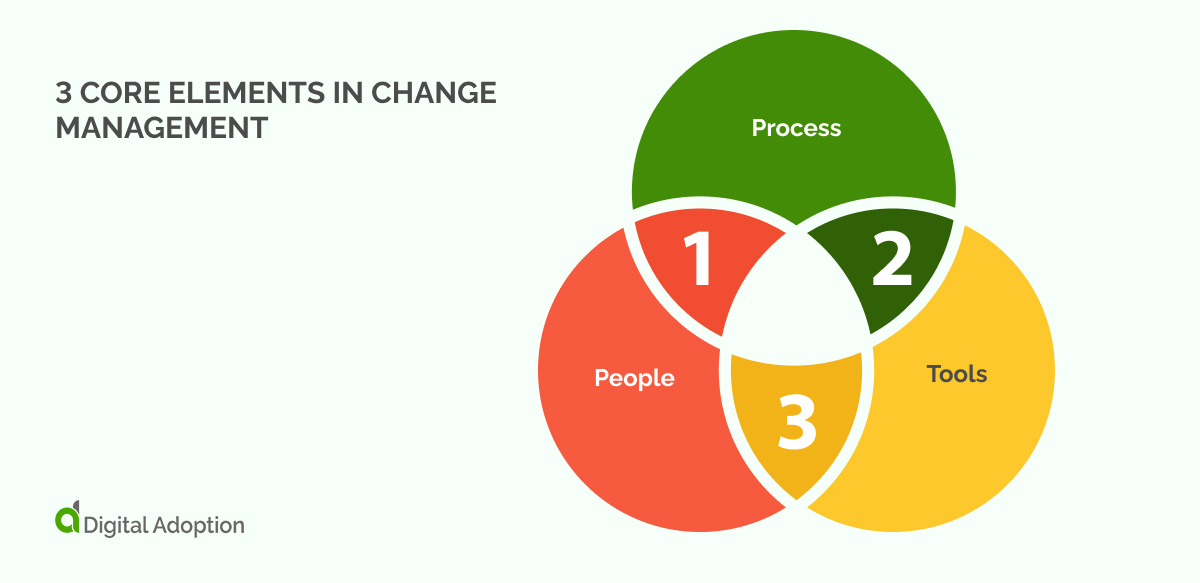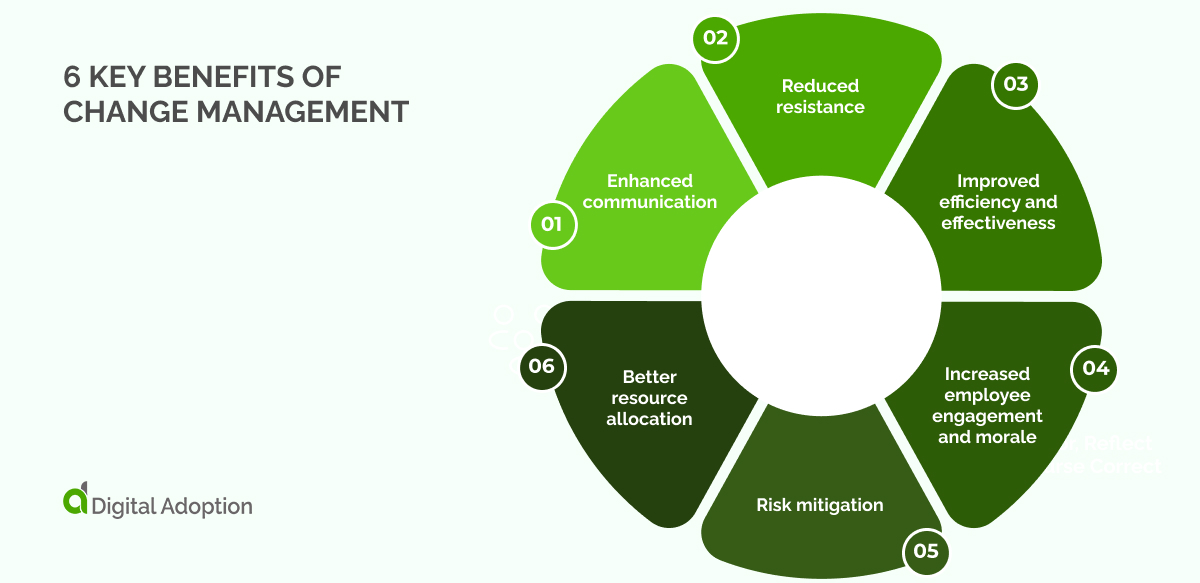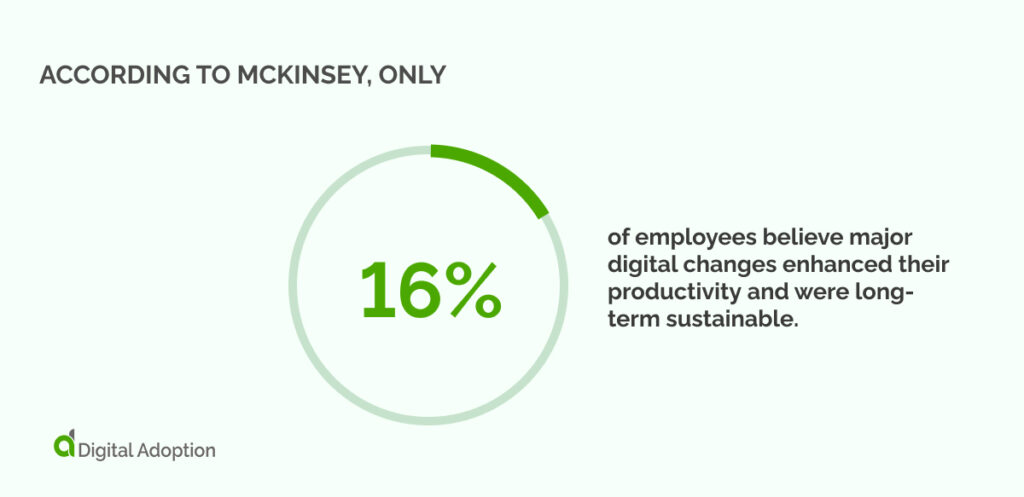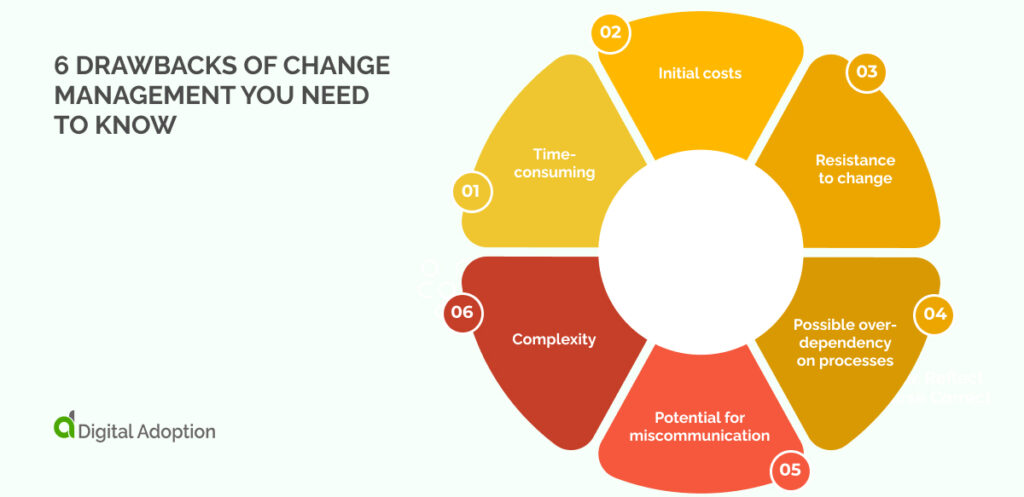Change management is about preparing and supporting your teams to adopt changes in order to drive organizational success and outcomes.
Change is inevitable, and your ability to manage that change is critical.
In this article, we’re covering the key benefits and drawbacks of change management. But we’re not doing this to convince you that you should be doing change management— you already know that.
Rather, we want you to grasp the pros and cons so you’re better positioned to make informed decisions and steer your organization toward sustainable growth.
By the time you’re done reading, you’ll have a new-found confidence in navigating the roiling landscape of change management.
Change management: A quick recap
So, what exactly is change management?
At its core, change management is the strategic approach you take to ensure that changes in your organization are smoothly implemented, and your desired outcomes are achieved.
It’s not just about introducing a change; it’s about making it work and ensuring everyone is on board.

Now, diving deeper, there are 3 core elements in change management you should be familiar with:
1. People
This is arguably the most crucial component.
Without the buy-in and cooperation of your employees, change initiatives can stall or fail.
Engaging and training them ensures that transitions are less disruptive and more effective.
2. Process
This involves the structured approach you use to introduce and solidify the change.
Think of it as the roadmap that guides you from point A to point B, ensuring you don’t miss any essential steps.
3. Tools
These are the resources and systems that support and facilitate the change.
They can range from software that tracks progress to communication platforms, to training materials.
Having a grasp on these components will equip you to manage change more effectively and guide your organization through transitions with greater confidence.
6 key benefits of change management

When you’re steering your organization through transitions, understanding the benefits of effective change management is a game-changer.
It helps you communicate with stakeholders and get buy-in for the change from leadership and employees alike.
As you delve deeper into change management, keep these 6 key benefits in mind.
They’re theoretical benefits and real outcomes that can set your business on a path of sustained growth and innovation.
1. Enhanced communication
By fostering open dialogue, you make everyone aware of the need for change and cultivate a culture where everyone feels they have a voice.
Gartner’s organizational change guidance encourages early transparency and employee-led change, allowing your organization to make changes faster and adapt quickly.
When you encourage stakeholder involvement, you’re tapping into a broader perspective, ensuring that the change is well-rounded and considerate of all aspects of your business.
2. Reduced resistance
According to McKinsey, only 16% of employees believe major digital changes enhanced their productivity and were long-term sustainable.

That almost certainly wasn’t the case, but it’s likely the change managers leading those changes didn’t do enough to combat employee resistance to change.
By actively helping your employees understand and embrace change, you remove barriers that could hinder the transition.
Addressing and mitigating fears and uncertainties can significantly reduce pushback, allowing for a smoother transformation.
3. Improved efficiency and effectiveness
Streamlining processes means you’re cutting out the clutter, making operations leaner and more dynamic.
Ensuring better alignment with organizational goals guarantees that every change pushes your company closer to its vision.
Gartner revealed in a keynote presentation in 2020 that becoming a “composable business” (that’s, a business that has invested heavily in change management) could help you outpace competitors by 80% in the speed of implementing new features.
4. Increased employee engagement and morale
When employees feel they are a part of the change process, their commitment and enthusiasm for the organization’s direction can soar.
Effective communication and execution of change can significantly boost morale, fostering a positive work environment.
5. Risk mitigation
By keeping an eye out for potential pitfalls early on, you’re less likely to be caught off guard.
Strategizing in advance ensures that you have a plan in place to tackle challenges that may arise unexpectedly.
6. Better resource allocation
Ensuring that time, money, and resources are used effectively during a change initiative means you’re getting the best bang for your buck.
By directing resources wisely, you enhance the likelihood of a successful transition.
6 drawbacks of change management you need to know

While the advantages of change management are plentiful, it’s equally important to be aware of the challenges you might face.
Understanding these 6 drawbacks allows you to proactively address them, ensuring that your change management initiatives are both effective and efficient.
1. Time-consuming
The initial stages of change management can be lengthy, as they require meticulous planning, open communication, and thorough training.
2. Initial costs
When you hire change management professionals, organize training sessions, and invest in tools and resources, there’s an upfront investment.
3. Resistance to change
Even with the best strategies in place, some individuals are inherently resistant to change.
This resistance can lead to potential friction among team members, creating additional challenges for you.
4. Possible over-dependency on processes
There’s a risk of concentrating excessively on procedures, potentially sidelining the human aspects of change.
Such a heavy reliance on processes can sometimes feel too bureaucratic, leading to frustrations within the team.
5. Potential for miscommunication
Without careful execution, messages can get lost or distorted, leading to misunderstandings and inefficiencies.
Miscommunication can sow confusion and even mistrust if not managed properly.
6. Complexity
While robust, Comprehensive change management strategies can sometimes add complexity to otherwise straightforward tasks.
Key considerations in change management

Diving into the world of change management isn’t just about recognizing its advantages and challenges; it’s about making it work for your organization.
It’s about making change management an ally in your organization’s journey, ensuring it’s a tool that truly facilitates growth and innovation.
While change management is a complex practice, we’ve distilled our experience into 2 key considerations. By focusing on these considerations, you’re setting yourself up for success.
Balancing the benefits and drawbacks
Change management isn’t a one-size-fits-all solution.
While it brings a plethora of benefits, you also need to be wary of the potential pitfalls.
It’s essential to weigh the pros and cons, ensuring that the strategies you adopt truly align with your organization’s objectives.
Adapting and customizing strategies
Every organization is unique, with its own set of challenges, cultures, and objectives.
Therefore, a generic approach to change management might not yield the desired results.
It’s vital to tailor your change management strategies to fit your specific organizational needs, ensuring that they resonate with your team and align with your goals.
Pros and cons aside: Change management is unavoidable

Change, in its many forms, is an inevitable aspect of organizational life.
According to Prophet, most digital changes (51%, to be precise) are fueled by market pressure and growth opportunities. Two unavoidable forces you’ll face.
Whether it’s driven by technology, market dynamics, or internal shifts, your organization will face transitions that require adept management.
As we’ve discussed, while change management offers numerous benefits, weighing those against the potential challenges is crucial.
The key is not to view change management as a mere process but as a strategic approach that molds and adapts to your unique organizational landscape.
Just remember that continuous evaluation and adaptation are vital.
Embrace change, harness its power, and steer your organization toward a prosperous future.












